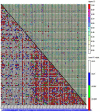Association mapping of seed oil and protein content in Sesamum indicum L. using SSR markers
- PMID: 25153139
- PMCID: PMC4143287
- DOI: 10.1371/journal.pone.0105757
Association mapping of seed oil and protein content in Sesamum indicum L. using SSR markers
Abstract
Sesame is an important oil crop for the high oil content and quality. The seed oil and protein contents are two important traits in sesame. To identify the molecular markers associated with the seed oil and protein contents in sesame, we systematically performed the association mapping among 369 worldwide germplasm accessions under 5 environments using 112 polymorphic SSR markers. The general linear model (GLM) was applied with the criteria of logP ≥ 3.0 and high stability under all 5 environments. Among the 369 sesame accessions, the oil content ranged from 27.89%-58.73% and the protein content ranged from 16.72%-27.79%. A significant negative correlation of the oil content with the protein content was found in the population. A total of 19 markers for oil content were detected with a R2 value range from 4% to 29%; 24 markers for protein content were detected with a R2 value range from 3% to 29%, of which 19 markers were associated with both traits. Moreover, partial markers were confirmed using mixed linear model (MLM) method, which suggested that the oil and protein contents are controlled mostly by major genes. Allele effect analysis showed that the allele associated with high oil content was always associated with low protein content, and vice versa. Of the 19 markers associated with oil content, 17 presented near the locations of the plant lipid pathway genes and 2 were located just next to a fatty acid elongation gene and a gene encoding Stearoyl-ACP Desaturase, respectively. The findings provided a valuable foundation for oil synthesis gene identification and molecular marker assistant selection (MAS) breeding in sesame.
Conflict of interest statement
Figures



Similar articles
-
A high-density genetic map constructed using specific length amplified fragment (SLAF) sequencing and QTL mapping of seed-related traits in sesame (Sesamum indicum L.).BMC Plant Biol. 2019 Dec 27;19(1):588. doi: 10.1186/s12870-019-2172-5. BMC Plant Biol. 2019. PMID: 31881840 Free PMC article.
-
Genetic analysis and molecular characterization of Chinese sesame (Sesamum indicum L.) cultivars using insertion-deletion (InDel) and simple sequence repeat (SSR) markers.BMC Genet. 2014 Mar 19;15:35. doi: 10.1186/1471-2156-15-35. BMC Genet. 2014. PMID: 24641723 Free PMC article.
-
Genetic discovery for oil production and quality in sesame.Nat Commun. 2015 Oct 19;6:8609. doi: 10.1038/ncomms9609. Nat Commun. 2015. PMID: 26477832 Free PMC article.
-
Food and nutraceutical functions of sesame oil: An underutilized crop for nutritional and health benefits.Food Chem. 2022 Sep 30;389:132990. doi: 10.1016/j.foodchem.2022.132990. Epub 2022 Apr 16. Food Chem. 2022. PMID: 35569244 Review.
-
Omics technologies towards sesame improvement: a review.Mol Biol Rep. 2023 Aug;50(8):6885-6899. doi: 10.1007/s11033-023-08551-w. Epub 2023 Jun 16. Mol Biol Rep. 2023. PMID: 37326753 Review.
Cited by
-
Comparative transcriptomic analysis provides insights into the genetic networks regulating oil differential production in oil crops.BMC Biol. 2024 May 13;22(1):110. doi: 10.1186/s12915-024-01909-x. BMC Biol. 2024. PMID: 38735918 Free PMC article.
-
Identification of Sesame Genomic Variations from Genome Comparison of Landrace and Variety.Front Plant Sci. 2016 Aug 3;7:1169. doi: 10.3389/fpls.2016.01169. eCollection 2016. Front Plant Sci. 2016. PMID: 27536315 Free PMC article.
-
Fine Mapping of a Major Pleiotropic QTL Associated with Sesamin and Sesamolin Variation in Sesame (Sesamum indicum L.).Plants (Basel). 2021 Jun 30;10(7):1343. doi: 10.3390/plants10071343. Plants (Basel). 2021. PMID: 34209452 Free PMC article.
-
Genome-Wide Discovery of InDel Markers in Sesame (Sesamum indicum L.) Using ddRADSeq.Plants (Basel). 2020 Sep 24;9(10):1262. doi: 10.3390/plants9101262. Plants (Basel). 2020. PMID: 32987937 Free PMC article.
-
Dissection of complicate genetic architecture and breeding perspective of cottonseed traits by genome-wide association study.BMC Genomics. 2018 Jun 13;19(1):451. doi: 10.1186/s12864-018-4837-0. BMC Genomics. 2018. PMID: 29895260 Free PMC article.
References
-
- Brummer EC, Graef GL, Orf J, Wilcox JR, Shoemaker RC (1997) Mapping QTL for seed protein and oil content in eight soybean populations. Crop Sci 37: 370–378.
-
- Guo SX (2011) Genetic and QTL analysis of oil content and other important quality traits on Brassica Napus L.). PhD thesis. Sichuan Agricultural University, Rice Institute.
-
- Turhan H, Citak N, Pehlivanoglu H, Mengul Z (2010) Effects of ecological and topographic conditions on oil content and fatty acid composition in sunflower. Bulgarian J Agri Sci 16: 553–558.
-
- Chen SL, Li YR, Cheng ZS, Liao BS, Lei Y, et al. (2009) Heterosis and Genetic Analysis of Oil Content in Peanut Using Mixed Model of Major Gene and Polygene. Scientia Agricultura Sinic 42: 3048–3057.
-
- Anilakumar KR, Pal A, Khanum F, Bawa AS (2010) Nutritional, medicinal and industrial uses of sesame (Sesamum indicum L.) seeds- an overview. Agric Conspec Sci 75: 159–168.
Publication types
MeSH terms
Substances
LinkOut - more resources
Full Text Sources
Other Literature Sources

